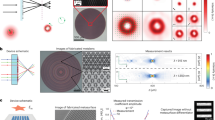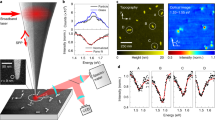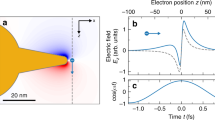Abstract
Metallic objects in close contact and illuminated by light show spectacular enhancements of electromagnetic fields due to excitation of surface plasmons, which have the potential for exploitation in ultra sensitive spectroscopy and in nonlinear phenomena. They also play a role in van der Waals forces, heat transfer and non contact friction. The extremes of lengthscales, varying from the micrometre to the subnanometre, challenge direct computational attack. Here we show that transformation optics enables an analytic approach that offers both physical insight and easy access to quantitative analysis. For two metal spheres at various separations we present details of the technique and discuss the optical absorption spectrum, spatial distribution of the modes and the van der Waals forces.
This is a preview of subscription content, access via your institution
Access options
Subscribe to this journal
Receive 12 print issues and online access
$209.00 per year
only $17.42 per issue
Buy this article
- Purchase on Springer Link
- Instant access to full article PDF
Prices may be subject to local taxes which are calculated during checkout





Similar content being viewed by others
References
Ward, A. J. & Pendry, J. B. Refraction and geometry in Maxwell’s equations. J. Mod. Opt. 43, 773–793 (1996).
Shyroki, D. M. Note on transformation to general curvilinear coordinates for Maxwell’s curl equations. Preprint at http://arxiv.org/abs/physics/0307029v1 (2003).
Schurig, D., Pendry, J. B. & Smith, D.R. Calculation of material properties and ray tracing in transformation media. Opt. Express 14, 9794–9804 (2006).
Leonhardt, U. Transformation optics and the geometry of light. Prog. Opt. 53, 69–152 (2009).
Kundtz, N. B., Smith, D. R. & Pendry, J. B. Electromagnetic design with transformation optics. Proc. IEEE 99, 1622–1633 (2011).
Pendry, J. B., Aubry, A., Smith, D. R. & Maier, S. A. Transformation optics and subwavelength control of light. Science 337, 549–552 (2012).
Pendry, J. B. Perfect Cylindrical lenses. Opt. Express 11, 755–760 (2003).
Pendry, J. B. Negative refraction makes a perfect lens. Phys. Rev. Lett. 85, 3966–3969 (2000).
Leonhardt, U. Optical conformal mapping. Science 312, 1777–1780 (2006).
Pendry, J. B., Schurig, D. & Smith, D. R. Controlling electromagnetic fields. Science 312, 1780–1782 (2006).
McPhedran, R. C. & McKenzie, D. R. Electrostatic and optical resonances of arrays of cylinders. Appl. Phys. A 23, 223–235 (1980).
McPhedran, R. C. & Perrins, W. T. Electrostatic and optical resonances of cylinder pairs. Appl. Phys. A 24, 311–318 (1981).
McPhedran, R. C. & Milton, G. W. Transport properties of touching cylinder pairs and of the square array of touching cylinders. Proc. R. Soc. A 411, 313–326 (1987).
Poladian, L. General theory of electrical images in sphere pairs. Q. J. Mech. Appl. Math. 41, 395–417 (1988).
Garcı´aVidal, F. J. & Pendry, J. B. A collective theory for surface enhanced Raman scattering. Phys. Rev. Lett. 77, 1163–1166 (1996).
Stockman, M. I. Nanofocusing of optical energy in tapered plasmonic waveguides. Phys. Rev. Lett. 93, 137404 (2004).
Talley, C. E. et al. Surface-enhanced Raman scattering from individual Au nanoparticles and nanoparticle dimer substrates. Nano Lett. 5, 1569–1574 (2005).
Sweatlock, L. A., Maier, S. A., Atwater, H. A., Penninkhof, J. J. & Polman, A. Highly confined electromagnetic fields in arrays of strongly coupled Ag nanoparticles. Phys. Rev. B 71, 235408 (2005).
Romero, I., Aizpurua, J., Bryant, G. W. & Garcıa de Abajo, F. J. Plasmons in nearly touching metallic nanoparticles: Singular response in the limit of touching dimers. Opt. Express 14, 9988–9999 (2006).
Hill, R. T. et al. Leveraging nanoscale plasmonic modes to achieve reproducible enhancement of light. Nano Lett. 10, 4150–4154 (2010).
Schuller, J. A. et al. Plasmonics for extreme light concentration and manipulation. Nature Mater. 9, 193–204 (2010).
Nordlander, P., Oubre, C., Prodan, E., Li, K. & Stockman, M. I. Plasmon hybridization in nanoparticle dimers. Nano Lett. 4, 899–903 (2004).
Garcı´a deAbajo, F. J. Nonlocal effects in the plasmons of strongly interacting nanoparticles, dimers, and waveguides. J. Phys. Chem. C 112, 17983–17987 (2008).
Aizpurua, J. & Rivacoba, S. Nonlocal effects in the plasmons of nanowires and nanocavities excited by fast electron beams. Phys. Rev. B 78, 035404 (2008).
Esteban, R., Borisov, A. G., Nordlander, P. & Aizpurua, J. Bridging quantum and classical plasmonics with a quantum-corrected model. Nature Commun. 3, 825 (2012).
Savage, K. J. et al. Revealing the quantum regime in tunnelling plasmonics. Nature 491, 574–577 (2012).
Landau, L. D. & Lifshitz, E. M. Electrodynamics of Continuous Media (Pergamon, 1963).
Palik, E. D. Handbook of Optical Constants of Solids (Academic, 1985).
Bimonte, G. & Emig, T. Exact results for classical Casimir interactions: Dirichlet and Drude model in the sphere–sphere and sphere-plane geometry. Phys. Rev. Lett. 109, 160403 (2012).
Israelachvili, J. N. Intermolecular and Surface Forces (Academic, 1998).
Acknowledgements
For our support we thank the following: the Gordon and Betty Moore Foundation (A.I.F-D. and J.B.P.), AFOSR (J.B.P.), the Royal Commission for the Exhibition of 1851 (R.Z), and the Leverhulme Trust (Y.L. and J.B.P.).
Author information
Authors and Affiliations
Contributions
All authors are deemed to have contributed equally.
Corresponding author
Ethics declarations
Competing interests
The authors declare no competing financial interests.
Rights and permissions
About this article
Cite this article
Pendry, J., Fernández-Domínguez, A., Luo, Y. et al. Capturing photons with transformation optics. Nature Phys 9, 518–522 (2013). https://doi.org/10.1038/nphys2667
Received:
Accepted:
Published:
Issue Date:
DOI: https://doi.org/10.1038/nphys2667
This article is cited by
-
Revealing topology with transformation optics
Nature Communications (2021)
-
Equivalence between positive and negative refractive index materials in electrostatic cloaks
Scientific Reports (2021)
-
Broadband single molecule SERS detection designed by warped optical spaces
Nature Communications (2018)
-
Optimized invisibility cloaks from the Logarithm conformal mapping
Scientific Reports (2016)
-
Omnidirectional optical attractor in structured gap-surface plasmon waveguide
Scientific Reports (2016)



